同济大学:《经济学》课程教学资源(教案讲义)Ch04 Producer Behavior
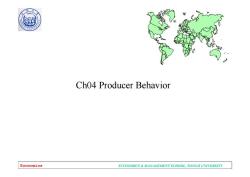
1907 Ch04 Producer Behavior Economics ECONOMICS MANAGEMENT SCHOOL,TONGJI UNIVERSITY
Economics ECONOMICS & MANAGEMENT SCHOOL, TONGJI UNIVERSITY Ch04 Producer Behavior

05-2 0 ④ Topics to be Discussed The Technology of Production ·Isoquants Production with One Variable Input (Labor) Production with Two Variable Inputs ·Returns to Scale Economics ECONOMICS MANAGEMENT SCHOOL,TONGJI UNIVERSITY
Economics ECONOMICS & MANAGEMENT SCHOOL, TONGJI UNIVERSITY 05-2 Topics to be Discussed • The Technology of Production • Isoquants • Production with One Variable Input (Labor) • Production with Two Variable Inputs • Returns to Scale
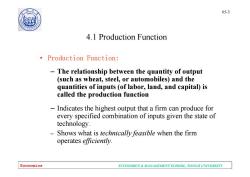
1907 05-3 4.1 Production Function Production Function: The relationship between the quantity of output (such as wheat,steel,or automobiles)and the quantities of inputs(of labor,land,and capital)is called the production function Indicates the highest output that a firm can produce for every specified combination of inputs given the state of technology. Shows what is technically feasible when the firm operates efficiently. Economics ECONOMICS MANAGEMENT SCHOOL,TONGJI UNIVERSITY
Economics ECONOMICS & MANAGEMENT SCHOOL, TONGJI UNIVERSITY 05-3 4.1 Production Function • Production Function: – The relationship between the quantity of output (such as wheat, steel, or automobiles) and the quantities of inputs (of labor, land, and capital) is called the production function – Indicates the highest output that a firm can produce for every specified combination of inputs given the state of technology. – Shows what is technically feasible when the firm operates efficiently
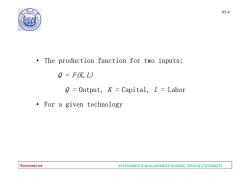
05-4 0 The production function for two inputs: Q=FK,L) Output,K=Capital,L Labor For a given technology Economics ECONOMICS MANAGEMENT SCHOOL,TONGJI UNIVERSITY
Economics ECONOMICS & MANAGEMENT SCHOOL, TONGJI UNIVERSITY 05-4 • The production function for two inputs: Q = F(K,L) Q = Output, K = Capital, L = Labor • For a given technology
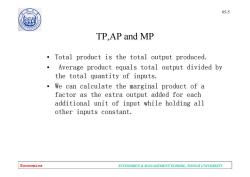
1907 05-5 TP,AP and MP Total product is the total output produced. Average product equals total output divided by the total quantity of inputs. We can calculate the marginal product of a factor as the extra output added for each additional unit of input while holding all other inputs constant. Economics ECONOMICS MANAGEMENT SCHOOL,TONGJI UNIVERSITY
Economics ECONOMICS & MANAGEMENT SCHOOL, TONGJI UNIVERSITY 05-5 TP,AP and MP • Total product is the total output produced. • Average product equals total output divided by the total quantity of inputs. • We can calculate the marginal product of a factor as the extra output added for each additional unit of input while holding all other inputs constant
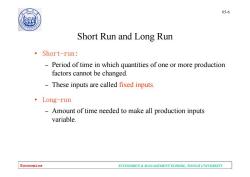
05-6 0 Short Run and Long Run 。Short-run: -Period of time in which quantities of one or more production factors cannot be changed. These inputs are called fixed inputs. ·Long-run Amount of time needed to make all production inputs variable. Economics ECONOMICS MANAGEMENT SCHOOL,TONGJI UNIVERSITY
Economics ECONOMICS & MANAGEMENT SCHOOL, TONGJI UNIVERSITY 05-6 Short Run and Long Run • Short-run: – Period of time in which quantities of one or more production factors cannot be changed. – These inputs are called fixed inputs. • Long-run – Amount of time needed to make all production inputs variable
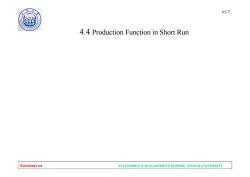
1907 05-7 4.4 Production Function in Short Run Economics ECONOMICS MANAGEMENT SCHOOL.TONGJI UNIVERSITY
Economics ECONOMICS & MANAGEMENT SCHOOL, TONGJI UNIVERSITY 05-7 4.4 Production Function in Short Run
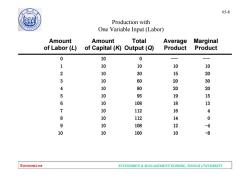
05-8 0 Production with One Variable Input (Labor) Amount Amount Total Average Marginal of Labor (L) of Capital(K)Output(Q) Product I Product 0 10 0 1 10 10 10 10 2 10 30 15 20 3 10 60 20 30 4 10 80 20 20 5 10 95 19 15 6 10 108 18 13 7 10 112 16 8 1 112 14 0 9 10 108 12 -4 10 0 100 10 -8 Economics ECONOMICS MANAGEMENT SCHOOL,TONGJI UNIVERSITY
Economics ECONOMICS & MANAGEMENT SCHOOL, TONGJI UNIVERSITY 05-8 Amount Amount Total Average Marginal of Labor (L) of Capital (K) Output (Q) Product Product Production with One Variable Input (Labor) 0 10 0 --- --- 1 10 10 10 10 2 10 30 15 20 3 10 60 20 30 4 10 80 20 20 5 10 95 19 15 6 10 108 18 13 7 10 112 16 4 8 10 112 14 0 9 10 108 12 -4 10 10 100 10 -8
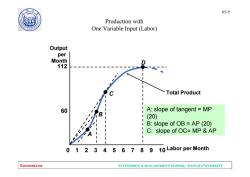
05-9 190 Production with One Variable Input (Labor) Output per Month 112 Total Product 60 A:slope of tangent MP (20) 1 B:slope of OB=AP(20) C:slope of OC=MP AP 0 1 23 4 56789 10 Labor per Month Economics ECONOMICS MANAGEMENT SCHOOL.TONGJI UNIVERSITY
Economics ECONOMICS & MANAGEMENT SCHOOL, TONGJI UNIVERSITY 05-9 Total Product Labor per Month Output per Month 60 112 0 2 3 4 5 6 7 8 9 10 1 A B C D Production with One Variable Input (Labor) A: slope of tangent = MP (20) B: slope of OB = AP (20) C: slope of OC= MP & AP
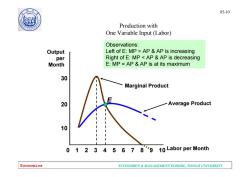
05-10 0 Production with One Variable Input (Labor) Observations: Output Left of E:MP>APAP is increasing per Right of E:MP AP AP is decreasing Month E:MP APAP is at its maximum 30 Marginal Product 20 Average Product 10 0 1 2 3 4 5 6 7 8"9 10Labor per Month Economics ECONOMICS MANAGEMENT SCHOOL,TONGJI UNIVERSITY
Economics ECONOMICS & MANAGEMENT SCHOOL, TONGJI UNIVERSITY 05-10 Average Product Production with One Variable Input (Labor) 8 10 20 Output per Month 0 2 3 4 5 6 7 9 10 1 Labor per Month 30 E Marginal Product Observations: Left of E: MP > AP & AP is increasing Right of E: MP < AP & AP is decreasing E: MP = AP & AP is at its maximum
按次数下载不扣除下载券;
注册用户24小时内重复下载只扣除一次;
顺序:VIP每日次数-->可用次数-->下载券;
- 同济大学:《经济学》课程教学资源(教案讲义)Ch03 Demand and Consumer Behavior.pdf
- 同济大学:《经济学》课程教学资源(教案讲义)Ch02-2 Applications of Supply and Demand.pdf
- 同济大学:《经济学》课程教学资源(教案讲义)Ch02-1 Supply and Demand.pdf
- 同济大学:《经济学》课程教学资源(教案讲义)Ch01 The Fundamentals of Economics(负责人:李永).pdf
- 同济大学:《经济学》课程教学资源(试卷习题)期终考试试卷(B卷)答案.pdf
- 同济大学:《经济学》课程教学资源(试卷习题)期终考试试卷(B卷)试题.pdf
- 同济大学:《经济学》课程教学资源(试卷习题)期终考试试卷(A卷)答案.pdf
- 同济大学:《经济学》课程教学资源(试卷习题)期终考试试卷(A卷)试题.pdf
- 安徽科技学院:《会计信息系统》课程教学资源(PPT课件)第七章 ERP应用概述.ppt
- 安徽科技学院:《会计信息系统》课程教学资源(PPT课件)第六章 会计信息系统审计.ppt
- 安徽科技学院:《会计信息系统》课程教学资源(PPT课件)第五章 会计信息系统的建设与管理.ppt
- 安徽科技学院:《会计信息系统》课程教学资源(PPT课件)第四章 其他业务核算子系统.ppt
- 安徽科技学院:《会计信息系统》课程教学资源(PPT课件)第三章 报表子系统.ppt
- 安徽科技学院:《会计信息系统》课程教学资源(PPT课件)第二章 账务处理子系统.ppt
- 安徽科技学院:《会计信息系统》课程教学资源(PPT课件)第一章 会计信息系统概述(主讲教师:王伟).ppt
- 安徽科技学院:《会计信息系统》课程教学资源(试卷习题)综合理论练习题及答案.doc
- 安徽科技学院:《会计信息系统》课程教学资源(试卷习题)复习思考题答案.doc
- 安徽科技学院:《会计信息系统》课程教学资源(试卷习题)练习题8.doc
- 安徽科技学院:《会计信息系统》课程教学资源(试卷习题)练习题7.doc
- 安徽科技学院:《会计信息系统》课程教学资源(试卷习题)练习题6.doc
- 同济大学:《经济学》课程教学资源(教案讲义)Ch05 Analysis of Cost.pdf
- 同济大学:《经济学》课程教学资源(教案讲义)Ch06-1 Analysis of Perfectly Competitive Markets.pdf
- 同济大学:《经济学》课程教学资源(教案讲义)Ch06-2 Imperfect Competition.pdf
- 同济大学:《经济学》课程教学资源(教案讲义)Ch07 General Equilibrium and Economic Efficiency.pdf
- 同济大学:《经济学》课程教学资源(教案讲义)Ch08 Market For Factors of Production.pdf
- 同济大学:《经济学》课程教学资源(教案讲义)Ch10 Overview of Macroeconomics.pdf
- 同济大学:《经济学》课程教学资源(教案讲义)Ch09 Externalities and Public Goods.pdf
- 同济大学:《经济学》课程教学资源(教案讲义)Ch11 National Income Accounting.pdf
- 同济大学:《经济学》课程教学资源(教案讲义)Ch12-1 Consumption and Investment.pdf
- 同济大学:《经济学》课程教学资源(教案讲义)Ch12-2 The Determination of Equilibrium Output.pdf
- 同济大学:《经济学》课程教学资源(教案讲义)Ch13 Money Market Equilibrium.pdf
- 同济大学:《经济学》课程教学资源(教案讲义)Ch14 Outputs and Money Market - IS-LM Model.pdf
- 同济大学:《经济学》课程教学资源(教案讲义)Ch15 Aggregate Demand And Supply.pdf
- 同济大学:《经济学》课程教学资源(教案讲义)Ch16 Economic Growth.pdf
- 吉林大学:《中央银行业务管理》课程教学资源(PPT课件)第一章 中央银行制度的形成和发展.ppt
- 吉林大学:《中央银行业务管理》课程教学资源(PPT课件)第七章 中央银行的其他业务.ppt
- 吉林大学:《中央银行业务管理》课程教学资源(PPT课件)第三章 中央银行业务活动的法规原则与资产负债表.ppt
- 吉林大学:《中央银行业务管理》课程教学资源(PPT课件)第九章 中央银行货币政策的目标与工具.ppt
- 吉林大学:《中央银行业务管理》课程教学资源(PPT课件)第二章 中央银行在现代经济体系中的地位与作用.ppt
- 吉林大学:《中央银行业务管理》课程教学资源(PPT课件)第五章 中央银行的资产业务.ppt
